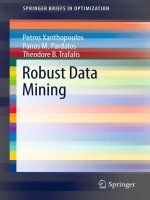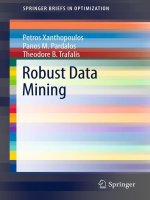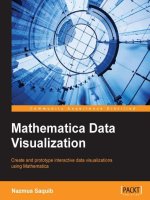IT training robust data mining xanthopoulos, pardalos trafalis 2012 11 21
Bạn đang xem bản rút gọn của tài liệu. Xem và tải ngay bản đầy đủ của tài liệu tại đây (4.5 MB, 67 trang )
SpringerBriefs in Optimization
Series Editors
Panos M. Pardalos
J´anos D. Pint´er
Stephen M. Robinson
Tam´as Terlaky
My T. Thai
SpringerBriefs in Optimization showcases algorithmic and theoretical techniques, case studies, and applications within the broad-based field of optimization.
Manuscripts related to the ever-growing applications of optimization in applied
mathematics, engineering, medicine, economics, and other applied sciences are
encouraged.
For further volumes:
/>
Petros Xanthopoulos • Panos M. Pardalos
Theodore B. Trafalis
Robust Data Mining
123
Petros Xanthopoulos
Department of Industrial Engineering
and Management Systems
University of Central Florida
Orlando, FL, USA
Panos M. Pardalos
Center for Applied Optimization
Department of Industrial
and Systems Engineering
University of Florida
Gainesville, FL, USA
Theodore B. Trafalis
School of Industrial
and Systems Engineering
The University of Oklahoma
Norman, OK, USA
Laboratory of Algorithms and Technologies
for Networks Analysis (LATNA)
National Research University
Higher School of Economics
Moscow, Russia
School of Meteorology
The University of Oklahoma
Norman, OK, USA
ISSN 2190-8354
ISSN 2191-575X (electronic)
ISBN 978-1-4419-9877-4
ISBN 978-1-4419-9878-1 (eBook)
DOI 10.1007/978-1-4419-9878-1
Springer New York Heidelberg Dordrecht London
Library of Congress Control Number: 2012952105
Mathematics Subject Classification (2010): 90C90, 62H30
© Petros Xanthopoulos, Panos M. Pardalos, Theodore B. Trafalis 2013
This work is subject to copyright. All rights are reserved by the Publisher, whether the whole or part of
the material is concerned, specifically the rights of translation, reprinting, reuse of illustrations, recitation,
broadcasting, reproduction on microfilms or in any other physical way, and transmission or information
storage and retrieval, electronic adaptation, computer software, or by similar or dissimilar methodology
now known or hereafter developed. Exempted from this legal reservation are brief excerpts in connection
with reviews or scholarly analysis or material supplied specifically for the purpose of being entered
and executed on a computer system, for exclusive use by the purchaser of the work. Duplication of
this publication or parts thereof is permitted only under the provisions of the Copyright Law of the
Publisher’s location, in its current version, and permission for use must always be obtained from Springer.
Permissions for use may be obtained through RightsLink at the Copyright Clearance Center. Violations
are liable to prosecution under the respective Copyright Law.
The use of general descriptive names, registered names, trademarks, service marks, etc. in this publication
does not imply, even in the absence of a specific statement, that such names are exempt from the relevant
protective laws and regulations and therefore free for general use.
While the advice and information in this book are believed to be true and accurate at the date of
publication, neither the authors nor the editors nor the publisher can accept any legal responsibility for
any errors or omissions that may be made. The publisher makes no warranty, express or implied, with
respect to the material contained herein.
Printed on acid-free paper
Springer is part of Springer Science+Business Media (www.springer.com)
To our families for their continuous support
on our work. . .
Preface
Real measurements involve errors and uncertainties. Dealing with data imperfections and imprecisions is one of the modern data mining challenges. The term
“robust” has been used by different disciplines such as statistics, computer science,
and operations research to describe algorithms immune to data uncertainties.
However, each discipline uses the term in a, slightly or totally, different context.
The purpose of this monograph is to summarize the applications of robust
optimization in data mining. For this we present the most popular algorithms such
as least squares, linear discriminant analysis, principal component analysis, and
support vector machines along with their robust counterpart formulation. For the
problems that have been proved to be tractable we describe their solutions.
Our goal is to provide a guide for junior researchers interested in pursuing
theoretical research in data mining and robust optimization. For this we assume
minimal familiarity of the reader with the context except of course for some basic
linear algebra and calculus knowledge. This monograph has been developed so that
each chapter can be studied independent of the others. For completion we include
two appendices describing some basic mathematical concepts that are necessary for
having complete understanding of the individual chapters. This monograph can be
used not only as a guide for independent study but also as a supplementary material
for a technically oriented graduate course in data mining.
Orlando, FL
Gainesville, FL
Norman, OK
Petros Xanthopoulos
Panos M. Pardalos
Theodore B. Trafalis
vii
Acknowledgments
Panos M. Pardalos would like to acknowledge the Defense Threat Reduction
Agency (DTRA) and the National Science Foundation (NSF) for the funding
support of his research.
Theodore B. Trafalis would like to acknowledge National Science Foundation
(NSF) and the U.S. Department of Defense, Army Research Office for the funding
support of his research.
ix
Contents
1
Introduction . . . . . . . . . . . . . . . . . . . . . . . . . . . . . . . . . . . . . . . . . . . . . .. . . . . . . . . . . . . . . . . . . . .
1.1 A Brief Overview . . . . . . . . . . . . . . . . . . . . . . . . . . . . . . . . . . .. . . . . . . . . . . . . . . . . . . . .
1.1.1 Artificial Intelligence . . . . . . . . . . . . . . . . . . . . . . .. . . . . . . . . . . . . . . . . . . . .
1.1.2 Computer Science/Engineering . . . . . . . . . . . .. . . . . . . . . . . . . . . . . . . . .
1.1.3 Optimization . . . . . . . . . . . . . . . . . . . . . . . . . . . . . . . .. . . . . . . . . . . . . . . . . . . . .
1.1.4 Statistics . . . . . . . . . . . . . . . . . . . . . . . . . . . . . . . . . . . . .. . . . . . . . . . . . . . . . . . . . .
1.2 A Brief History of Robustness . . . . . . . . . . . . . . . . . . . . .. . . . . . . . . . . . . . . . . . . . .
1.2.1 Robust Optimization vs Stochastic Programming.. . . . . . . . . . . . .
1
1
2
2
3
4
5
6
2 Least Squares Problems .. . . . . . . . . . . . . . . . . . . . . . . . . . . . . . . .. . . . . . . . . . . . . . . . . . . . .
2.1 Original Problem .. . . . . . . . . . . . . . . . . . . . . . . . . . . . . . . . . . .. . . . . . . . . . . . . . . . . . . . .
2.2 Weighted Linear Least Squares . . . . . . . . . . . . . . . . . . . .. . . . . . . . . . . . . . . . . . . . .
2.3 Computational Aspects of Linear Least Squares . .. . . . . . . . . . . . . . . . . . . . .
2.3.1 Cholesky Factorization . . . . . . . . . . . . . . . . . . . . .. . . . . . . . . . . . . . . . . . . . .
2.3.2 QR Factorization .. . . . . . . . . . . . . . . . . . . . . . . . . . .. . . . . . . . . . . . . . . . . . . . .
2.3.3 Singular Value Decomposition .. . . . . . . . . . . .. . . . . . . . . . . . . . . . . . . . .
2.4 Least Absolute Shrinkage and Selection Operator . . . . . . . . . . . . . . . . . . . . .
2.5 Robust Least Squares . . . . . . . . . . . . . . . . . . . . . . . . . . . . . . .. . . . . . . . . . . . . . . . . . . . .
2.5.1 Coupled Uncertainty .. . . . . . . . . . . . . . . . . . . . . . .. . . . . . . . . . . . . . . . . . . . .
2.6 Variations of the Original Problem .. . . . . . . . . . . . . . . .. . . . . . . . . . . . . . . . . . . . .
2.6.1 Uncoupled Uncertainty .. . . . . . . . . . . . . . . . . . . .. . . . . . . . . . . . . . . . . . . . .
9
9
12
12
13
13
13
14
14
14
17
19
3 Principal Component Analysis . . . . . . . . . . . . . . . . . . . . . . . . .. . . . . . . . . . . . . . . . . . . . .
3.1 Problem Formulations . . . . . . . . . . . . . . . . . . . . . . . . . . . . . .. . . . . . . . . . . . . . . . . . . . .
3.1.1 Maximum Variance Approach . . . . . . . . . . . . .. . . . . . . . . . . . . . . . . . . . .
3.1.2 Minimum Error Approach.. . . . . . . . . . . . . . . . .. . . . . . . . . . . . . . . . . . . . .
3.2 Robust Principal Component Analysis . . . . . . . . . . . . .. . . . . . . . . . . . . . . . . . . . .
21
21
22
23
24
4 Linear Discriminant Analysis . . . . . . . . . . . . . . . . . . . . . . . . . .. . . . . . . . . . . . . . . . . . . . .
4.1 Original Problem .. . . . . . . . . . . . . . . . . . . . . . . . . . . . . . . . . . .. . . . . . . . . . . . . . . . . . . . .
4.1.1 Generalized Discriminant Analysis . . . . . . . .. . . . . . . . . . . . . . . . . . . . .
4.2 Robust Discriminant Analysis .. . . . . . . . . . . . . . . . . . . . .. . . . . . . . . . . . . . . . . . . . .
27
27
30
31
xi
xii
Contents
5 Support Vector Machines . . . . . . . . . . . . . . . . . . . . . . . . . . . . . . .. . . . . . . . . . . . . . . . . . . . .
5.1 Original Problem .. . . . . . . . . . . . . . . . . . . . . . . . . . . . . . . . . . .. . . . . . . . . . . . . . . . . . . . .
5.1.1 Alternative Objective Function.. . . . . . . . . . . .. . . . . . . . . . . . . . . . . . . . .
5.2 Robust Support Vector Machines . . . . . . . . . . . . . . . . . .. . . . . . . . . . . . . . . . . . . . .
5.3 Feasibility-Approach as an Optimization Problem .. . . . . . . . . . . . . . . . . . . .
5.3.1 Robust Feasibility-Approach and Robust
SVM Formulations . . . . . . . . . . . . . . . . . . . . . . . . .. . . . . . . . . . . . . . . . . . . . .
35
35
41
42
45
45
6 Conclusion . . . . . . . . . . . . . . . . . . . . . . . . . . . . . . . . . . . . . . . . . . . . . . . .. . . . . . . . . . . . . . . . . . . . . 49
A Optimality Conditions .. . . . . . . . . . . . . . . . . . . . . . . . . . . . . . . . . .. . . . . . . . . . . . . . . . . . . . . 51
B Dual Norms . . . . . . . . . . . . . . . . . . . . . . . . . . . . . . . . . . . . . . . . . . . . . . .. . . . . . . . . . . . . . . . . . . . . 55
References .. .. . . . . . . . . . . . . . . . . . . . . . . . . . . . . . . . . . . . . . . . . . . . . . . . . .. . . . . . . . . . . . . . . . . . . . . 57
Chapter 1
Introduction
Abstract Data mining (DM), conceptually, is a very general term that encapsulates
a large number of methods, algorithms, and technologies. The common denominator
among all these is their ability to extract useful patterns and associations from data
usually stored in large databases. Thus DM techniques aim to provide knowledge
and interesting interpretation of, usually, vast amounts of data. This task is crucial,
especially today, mainly because of the emerging needs and capabilities that
technological progress creates. In this monograph we investigate some of the most
well-known data mining algorithms from an optimization perspective and we study
the application of robust optimization (RO) in them. This combination is essential
in order to address the unavoidable problem of data uncertainty that arises in almost
all realistic problems that involve data analysis. In this chapter we provide some
historical perspectives of data mining and its foundations and at the same time we
“touch” the concepts of robust optimization and discuss its differences compared to
stochastic programming.
1.1 A Brief Overview
Before we state the mathematical problems of this monograph, we provide, for
the sake of completion, a historical and methodological overview of data mining
(DM). Historically DM was evolved, in its current form, during the last few decades
from the interplay of classical statistics and artificial intelligence (AI). It is worth
mentioning that through this evolution process DM developed strong bonds with
computer science and optimization theory. In order to study modern concepts and
trends of DM we first need to understand its foundations and its interconnections
with the four aforementioned disciplines.
P. Xanthopoulos et al., Robust Data Mining, SpringerBriefs in Optimization,
DOI 10.1007/978-1-4419-9878-1 1,
© Petros Xanthopoulos, Panos M. Pardalos, Theodore B. Trafalis 2013
1
2
1 Introduction
1.1.1 Artificial Intelligence
The perpetual need/desire of human to create artificial machines/algorithms able
to learn, decide, and act as humans, gave birth to AI. Officially AI was born in
1956 in a conference held at Dartmouth College. The term itself was coined by
J. McCarthy during that conference. The goals of AI stated at this first conference,
even today, might be characterized as superficial from a pessimist perspective or
as challenging from an optimistic perspective. By reading again the proceedings of
this conference, we can see the rough expectations of the early AI community: “To
proceed on the basis of the conjecture that every aspect of learning or any other
feature of intelligence can be so precisely described that a machine can be made to
simulate it” [37]. Despite the fact that even today understanding the basic underlying
mechanisms of cognition and human intelligence remain an open problem for
computational and clinical scientists, this founding conference of AI stimulated
the scientific community and triggered the development of algorithms and methods
that became the foundations of modern machine learning. For instance, bayesian
methods were developed and further studied as part of AI research. Computer
programming languages like LISP [36] and PROLOG [14] were also developed for
serving AI purposes, and algorithms such as perceptron [47], backpropagation [15],
and in general artificial neural networks (ANN) were invented for the same purpose.
1.1.2 Computer Science/Engineering
In literature DM is often classified as a branch of computer science (CS). Indeed a lot
of DM research has been driven by CS society. In addition to this, there were several
advances of CS that boosted DM research. Database modeling together with smart
search algorithms made possible the indexing and processing of massive databases
[1,44]. The advances, in software level, of database modeling and search algorithms
were accompanied by a parallel development of semiconductor technologies and
computer hardware engineering.
In fact there is a feedback relation between DM and computer engineering that
drives the research in both areas. Computer engineering provides cheaper and larger
storage and processing power. On the other hand these new capabilities pose new
problems for DM society, often related to the processing of such amounts of data.
These problems create new algorithms and new needs for processing power that is
in turns addressed by computer engineering society. The progress in this area can
be best described by the so-called Moore’s “law” (named after Intel’s cofounder
G. E. Moore) that predicted that the number of transistors on a chip will double
every 24 months [39]. The predictions of this simple rule have been accurate at least
until today (Fig. 1.1).
Similar empirical “laws” have been stated for hard drive capacity and hard
drive price. Hard drive capacity increases ten times every 5 years and the cost
1.1 A Brief Overview
3
Number of Transistors
109
108
107
106
105
Intel
AMD
104
103
1970
1975
1980
1985
1990 1995
Year
2000
2005
2010
Fig. 1.1 Moore’s “law” drives the semiconductor market even today. This plot shows the transistor
count of several processors from 1970 until today for two major processor manufacturing
companies (Intel and AMD). Data source: count
Cost per Gb ($)
101
100
10−1
2000
2002
2004
2006
Year
2008
2010
Fig. 1.2 Kryder’s “law” describes the exponential decrease of computer storage cost over time.
This rule is able to predict approximately the cost of storage space over the last decade
drops ten times every five years. This empirical observation is known as Kryder’s
“law” (Fig. 1.2) [61]. Similar rule which is related to network bandwidth per user
(Nielsen’s “law”) indicates that it increases by 50% annually [40]. The fact that
computer progress is characterized by all these exponential empirical rules is in
fact indicative of the continuous and rapid transformation of DM’s needs and
capabilities.
1.1.3 Optimization
Mathematical theory of optimization is a branch of mathematics that was originally
developed for serving the needs of operations research (OR). It is worth noting
4
1 Introduction
n
rm
ati
o
re
ctu
n
inf
o
u
str
io
cis
de
da
ta
Applications
efficiency
Data Mining
Operations Research
effectiveness
Fig. 1.3 The big picture. Scheme capturing the inderdependence among DM, OR, and the various
application fields
that a large amount of data mining problems can be described as optimization
problems, sometimes tractable, sometimes not. For example, principal component
analysis (PCA) and Fisher’s linear discriminant analysis (LDA) are formulated as
minimization/ maximization problems of certain statistical functionals [11]. Support
vector machines (SVMs) can be described as a convex optimization problem
[60] and linear programming can be used for development of supervised learning
algorithms [35]. In addition several optimization metaheuristics have been proposed
for adjusting the parameters of supervised learning models [12]. On the other side,
data mining methods are often used as preprocessing for before employing some
optimization model (e.g., clustering). In addition a branch of DM involves network
models and optimization problems on networks for understanding the complex
relationships between the nodes and the edges. In this sense optimization is a tool
that can be employed in order to solve DM problems. In a recent review paper the
interplay of operations research data mining and applications was described by the
scheme shown in Fig. 1.3 [41].
1.1.4 Statistics
Statistics set the foundation for many concepts broadly used in data mining. Historically, one of the first attempts to understand interconnection between data was Bayes
analysis in 1763 [5]. Other concepts include regression analysis, hypothesis testing,
PCA, and LDA. As discussed, in modern DM it is very common to maximize or
minimize certain statistical quantities in order to achieve some clustering (grouping)
or to find interconnections and patterns among groups of data.
1.2 A Brief History of Robustness
5
1.2 A Brief History of Robustness
The term “robust” is used extensively in engineering and statistics literature. In
engineering it is often used in order to denote error resilience in general, e.g.,
robust methods are these that are not affected much by small error interferences.
In statistics robust is used to describe all these methods that are used when the
model assumptions are not exactly true, e.g., variables follow exactly the assumed
distribution (existence of outliers). In optimization (minimization of maximization)
robustness is used in order to describe the problem of finding the best solution given
that the problem data are not fixed but obtain their values within a well-defined
uncertainty set. Thus if we consider the minimization problem (without loss of
generality)
min f (A, x)
(1.1a)
x∈X
where A accounts for all the parameters of the problem that are considered to
be fixed numbers, and f (·) is the objective function, the robust counterpart (RC)
problem is going to be a min–max problem of the following form:
min max f (A, x)
x∈ X A∈A
(1.2a)
where A is the set of all admissible perturbations. The maximization problem
over the parameters A corresponds, usually, to a worst case scenario. The objective
of robust optimization is to determine the optimal solution when such a scenario
occurs. In real data analysis problems it is very likely that data might be corrupted,
perturbed, or subject to errors related to data acquisition. In fact most of the modern
data acquisition methods are prone to errors. The most usual source of such errors is
noise which is usually associated with the instrumentation itself or due to human
factors (when the data collection is done manually). Spectroscopy, microarray
technology, and electroencephalography (EEG) are some of the most commonly
used data collection technologies that are subject to noise. Robust optimization is
employed not only when we are dealing with data imprecisions but also when we
want to provide stable solutions that can be used in case of input modification. In
addition it can be used in order to avoid selection of “useless” optimal solutions
i.e. solutions that change drastically for small changes of data. Especially in case
where an optimal solution cannot be implemented precisely, due to technological
constraints, we wish that the next best optimal solution will be feasible and very
close to the one that is out of our implementation scope. For all these reasons, robust
methods and solutions are highly desired.
In order to outline the main goal and idea of robust optimization we will use
the well-studied example of linear programming (LP). In this problem we need to
determine the global optimum of a linear function over the feasible region defined
by a linear system.
min cT x
(1.3a)
s.t. Ax = b
x≥0
(1.3b)
(1.3c)
6
1 Introduction
where A ∈ Rn×m , b ∈ Rn , c ∈ Rm . In this formulation x is the decision variable and
A, b, c are the data and they have constant values. The LP for fixed data values can
be solved efficiently by many algorithms (e.g., SIMPLEX) and has been shown that
it can be solved in polynomial time [28].
In the case of uncertainty, we assume that data are not fixed but they can take any
values within an uncertainty set with known boundaries. Then the robust counterpart
(RC) problem is to find a vector x that minimizes (1.3a) for the “worst case”
perturbation. This worst case problem can be stated as a maximization problem
with respect to A, b, and c. The whole process can beformulated as the following
min–max problem:
min max cT x
(1.4a)
x
A,b,c
s.t. Ax = b
x≥0
(1.4b)
(1.4c)
A ∈ A , b ∈ B, c ∈ C
(1.4d)
where A , B, C are the uncertainty sets of A, b, c correspondingly. problem (1.4) can
be tractable or untractable based on the uncertainty sets properties. For example, it
has been shown that if the columns of A follow ellipsoidal uncertainty constraints
the problem is polynomially tractable [7]. Bertsimas and Sim showed that if
the coefficients of A matrix are between a lower and an upper bound, then this
problem can be still solved with linear programming [9]. Also Bertsimas et al. have
shown that an uncertain LP with general norm bounded constraints is a convex
programming problem [8]. For a complete overview of robust optimization, we
refer the reader to [6]. In the literature there are numerous studies providing with
theoretical or practical results on robust formulation of optimization problems.
Among others mixed integer optimization [27], conic optimization [52], global
optimization [59], linear programming with right-hand side uncertainty [38], graph
partitioning [22], and critical node detection [21].
1.2.1 Robust Optimization vs Stochastic Programming
Here it is worth noting that robust optimization is not the only approach for
handling uncertainty in optimization. In the robust framework the information
about uncertainty is given in a rather deterministic form of worst case bounding
constraints. In a different framework one might not require the solution to be feasible
for all data realization but to obtain the best solution given that problem data are
random variables following a specific distribution. This is of particular interest when
the problem possesses some periodic properties and historical data are available. In
this case the parameters of such a distribution could efficiently be estimated through
some model fitting approach. Then a probabilistic description of the constraints
can be obtained and the corresponding optimization problem can be classified as
1.2 A Brief History of Robustness
7
a stochastic programming problem. Thus the stochastic equivalent of the linear
program (1.3a) will be:
min t
x,t
s.t. Pr{cT x ≤ t, Ax ≤ b} ≥ p
x≥0
(1.5a)
(1.5b)
(1.5c)
where c, A, and b are random variables that follow some known distribution, p is
a nonnegative number less than 1 and Pr{·} some legitimate probability function.
This non-deterministic description of the problem does not guarrantee that the
provided solution would be feasible for all data set realizations but provides a
less conservative optimal solution taking into consideration the distribution-based
uncertainties. Although the stochastic approach might be of more practical value in
some cases, there are some assumptions made that one should be aware of [6]:
1. The problem must be of stochastic nature and that indeed there is a distribution
hidden behind each variable.
2. Our solution depends on our ability to determine the correct distribution from the
historic data.
3. We have to be sure that our problem accepts probabilistic solutions, i.e., a
stochastic problem solution might not be immunized against a catastrophic
scenario and a system might be vulnerable against rare event occurrence.
For this, the choice of the approach strictly depends on the nature of the problem
as well as the available data. For an introduction to stochastic programming, we
refer the reader to [10].
Chapter 2
Least Squares Problems
Abstract In this chapter we provide an overview of the original minimum least
squares problem and its variations. We present their robust formulations as they
have been proposed in the literature so far. We show the analytical solutions for
each variation and we conclude the chapter with some numerical techniques for
computing them efficiently.
2.1 Original Problem
In the original linear least squares (LLS) problem one needs to determine a linear
model that approximates “best” a group of samples (data points). Each sample
might correspond to a group of experimental parameters or measurements and each
individual parameter to a feature or, in statistical terminology, to a predictor. In
addition, each sample is characterized by an outcome which is defined by a real
valued variable and might correspond to an experimental outcome. Ultimately we
wish to determine a linear model able to issue outcome prediction for new samples.
The quality of such a model can be determined by a minimum distance criterion
between the samples and the linear model. Therefore if n data points, of dimension
m each, are represented by a matrix A ∈ Rn×m and the outcome variable by a vector
b ∈ Rn (each entry corresponding to a row of matrix A), we need to determine a
vector x ∈ Rm such that the residual error, expressed by some norm, is minimized.
This can be stated as:
min Ax − b
x
2
2
(2.1)
where · 2 is the Euclidean norm of a vector. The objective function value is also
called residual and denoted r(A, b, x) or just r. The geometric interpretation of this
problem is to find a vector x such that the sum of the distances between the points
represented by the rows of matrix A and the hyperplane defined by xT w − b = 0
(where w is the independent variable) is minimized. In this sense this problem is a
P. Xanthopoulos et al., Robust Data Mining, SpringerBriefs in Optimization,
DOI 10.1007/978-1-4419-9878-1 2,
© Petros Xanthopoulos, Panos M. Pardalos, Theodore B. Trafalis 2013
9
10
2 Least Squares Problems
100
80
b
60
40
20
0
−20
−40
−120−100 −80 −60 −40 −20
0
a
20
40
60
80
100 120
Fig. 2.1 The single input single outcome case. This is a 2D example the predictor represented by
the a variable and the outcome by vertical axis b
first order polynomial fitting problem. Then by determining the optimal x vector will
be able to issue predictions for new samples by just computing their inner product
with x. An example in two dimensions (2D) can be seen in Fig. 2.1. In this case
the data matrix will be A = [a e] ∈ Rn×2 where a is the predictor variable and e a
column vector of ones that accounts for the constant term.
The problem can be solved, in its general form, analytically since we know
that the global minimum will be at a Karush–Kuhn–Tucker (KKT) point (since
the problem is convex and unconstrained) the Lagrangian equation LLLS (x) will
be given by the objective function itself and the KKT points can be obtained by
solving the following equation:
dLLLS (x)
= 0 ⇔ 2AT Ax = AT b
dx
(2.2)
In case that A is of full row rank, that is rank(A) = n, matrix AT A is invertible
and we can write:
xLLS = AT A
−1
AT b
A† b
(2.3)
Matrix A† is also called pseudoinverse or Moore–Penrose matrix. It is very
common that the full rank assumption is not always valid. In such case the most
common way to address the problem is through regularization. One of the most
famous regularization techniques is the one known as Tikhonov regularization [55].
In this case instead of problem (2.1) we consider the following problem:
min
x
Ax − b
2
+δ x
2
(2.4)
2.1 Original Problem
11
100
80
b
60
40
20
δ
δ
δ
δ
δ
δ
δ
= 0.0
= 0.1
= 1.0
= 2.0
= 4.0
= 8.0
=16.0
0
−20
−40
−120−100 −80 −60 −40 −20
0
a
20
40
60
80
100
120
Fig. 2.2 LLS and regularization. Change of linear least squares solution with respect to different δ
values. As we can observe, in this particular example, the solution hyperplane is slightly perturbed
for different values of δ
by using the same methodology we obtain:
dLRLLS(x)
= 0 ⇔ AT (Ax − b) + δ Ix = 0 ⇔ (AT A + δ I)x = AT b
dx
(2.5)
where I is a unit matrix of appropriate dimension. Now even in case that AT A is not
invertible we can compute x by
xRLLS = (AT A + δ I)−1AT b
(2.6)
This type of least square solution is also known as ridge regression. The
parameter δ controls the trade-off between optimality and stability. Originally
regularization was proposed in order to overcome this practical difficulty that arises
in real problems and it is related to rank deficiency described earlier. The value of δ
is determined usually by trial and error and its magnitude is smaller compared to the
entries of data matrix. In Fig. 2.2 we can see how the least squares plane changes
for different values of delta.
In Sect. 2.5 we will examine the relation between robust linear least squares and
robust optimization.
12
2 Least Squares Problems
2.2 Weighted Linear Least Squares
A slight, and more general, modification of the original least squares problem is the
weighted linear least squares problem (WLLS). In this case we have the following
minimization problem:
min rTW r = min (Ax − b)TW (Ax − b) = min W 1/2 (Ax − b)
x
x
x
(2.7)
where W is the weight matrix. Note that this is a more general formulation since
for W = I the problem reduces to (2.1). The minimum can be again obtained by the
solution of the corresponding KKT systems which is:
2ATW (Ax − b) = 0
(2.8)
and gives the following solution:
xWLLS = (ATWA)−1 ATW b
(2.9)
assuming that ATWA is invertible. If this is not the case regularization is employed
resulting in the following regularized weighted linear least squares (RWLLS)
problem
W 1/2 (Ax − b)
(2.10)
xRWLLS = (ATWA + δ I)−1AW b
(2.11)
x
2
+δ x
2
min
that attains its global minimum for
Next we will discuss some practical approaches for computing least square solution
for all the discussed variations of the problem.
2.3 Computational Aspects of Linear Least Squares
Least squares solution can be obtained by computing an inverse matrix and applying
a couple of matrix multiplications. However, in practice, direct matrix inversion is
avoided, especially due to the high computational cost and solution instabilities.
Here we will describe three of the most popular methods used for solving the least
squares problems.
2.3 Computational Aspects of Linear Least Squares
13
2.3.1 Cholesky Factorization
When matrix A is of full rank, then AAT is invertible and can be decomposed through
Cholesky decomposition in a product LLT where L is a lower triangular matrix. Then
(2.2) can be written as:
LLT x = AT b
(2.12)
that can be solved by a forward substitution followed by a backward substitution. In
case that A is not of full rank, then this procedure can be applied to the regularized
problem (2.5).
2.3.2 QR Factorization
An alternative method is the one of QR decomposition. In this case we decompose
matrix AAT into a product of two matrices where the first matrix Q is orthogonal
and the second matrix R is upper triangular. This decomposition again requires data
matrix A to be of full row rank. Orthogonal matrix Q has the property QQT = I thus
the problem is equivalent to
Rx = QT AT b
(2.13)
and it can be solved by backward substitution.
2.3.3 Singular Value Decomposition
This last method does not require full rank of matrix A. It uses the singular value
decomposition of A:
A = UΣV T
(2.14)
where U and V are orthogonal matrices and Σ is diagonal matrix that has the singular
values. Every matrix with real elements has an SVD and furthermore it can be
proved that a matrix is of full row rank if and only if all of its singular values are
nonzero. Substituting with its SVD decomposition we get:
AAT x = (UΣV T )(V ΣU T )x = UΣ2U T x = AT b
(2.15)
x = U(Σ2 )†U T AT b
(2.16)
and finally
(Σ2 )†
can be computed easily by inverting its nonzero entries. If A is
The matrix
of full rank then all singular values are non-zero and (Σ2 )† = (Σ2 )−1 . Although SVD
can be applied to any kind of matrix it is computationally expensive and sometimes
is not preferred especially when processing massive datasets.









